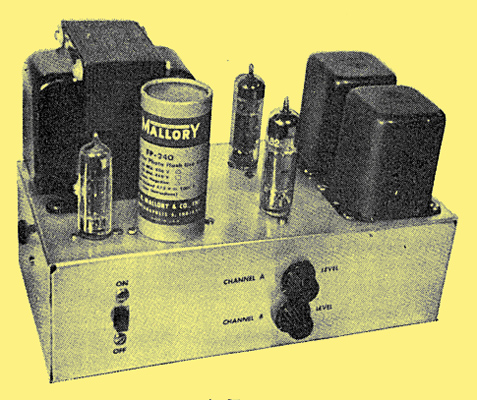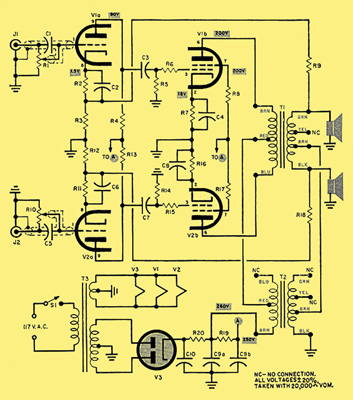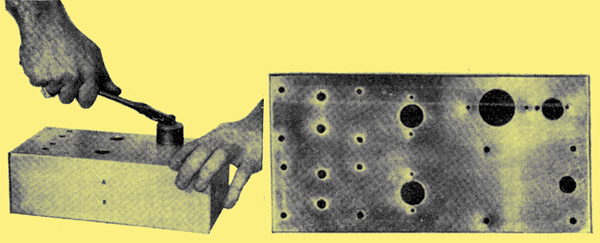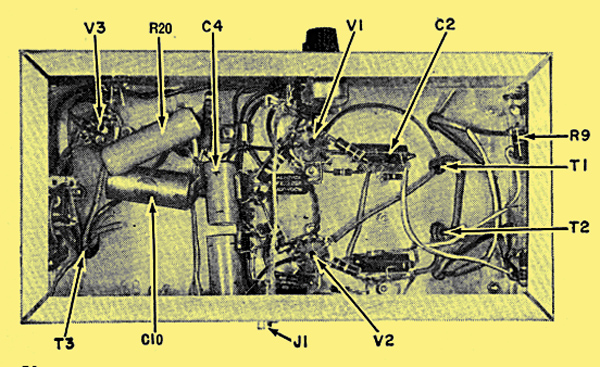|

The amplifier to be described here was designed and built as a practical application of stereo simplex principles. High quality stereo at maximum economy was the goal, and anyone who has been reluctant to shell out the money for two amplifiers, or who would like a second stereo system for his playroom or summer house, will find that the 'Stereoplex' is an excellent choice.
The Stereoplex consists of a simplex-connected push-pull feedback amplifier plus a power supply on a 5 x 7 x 3 inch chassis. It employs only three valves: two 6BM8/ECL82 voltage amplifier-output valves, and one 6X4 rectifier.
The compactness and low cost of the Stereoplex is made possible through the recent introduction of a new audio tube by Amperex and a recent modification of the simplex circuit by CBS. The new tube - the 6BM8/ECL82 - is a 9-pin miniature tube combining a high-mu triode and a power output pentode in the same envelope. These combined characteristics of the 6BM8/ECL82 allow the design of a medium-power amplifier with but two tubes plus rectifier. The further advantages of simplex operation permit this amplifier to serve as a complete two-channel stereo amplifier.
Features

Voltages indicated at V1s socket in the circuit diagram will be close but not identical to those of V2.
Despite its compactness and simplicity of construction, the Stereoplex boasts an effective output of 10 Watts from each channel. At an output level of one Watt, the frequency response is flat within ±1 dB from 30 Hz to 20,000 Hz and is down only 1.8 dB at 20 Hz. Use of negative feedback results in a total harmonic distortion of only 1.5% at full output.
Channel separation is 25 dB at 1,000 Hz, hum and noise is down 70 dB. Each channel is equipped with its own volume control, and a power take-off socket may be added to provide power for auxiliary equipment.
The input sensitivity is high enough so that most ceramic or crystal stereo cartridges may be plugged in directly, thus eliminating the need for a preamplifier. These stereo cartridges usually have 0.25 to 0.5 Volt output, and are relatively inexpensive. The author has had excellent results with the Sonotone 8T, the CBS-Hytron SC-2, and the Ronnette BF-40 stereo cartridges.
Construction

The chassis as it appears after drilling and punching. Use of Greenlee punches greatly facilitates chassis preparation.
The first step in construction is the preparation of the chassis. A light aluminum chassis is recommended since it is easily worked and helps minimize stray hum paths. Lay out the chassis as shown. If you have a set of chassis punches, the task will be greatly facilitated. For a professional-looking job the drilled and punched chassis may be rubbed with fine steel wool, then sprayed with clear Krylon lacquer to preserve the lustre. Application of Walsco audio decals will add the finishing touch.
Mount the tie points first since it may be awkward to do so later. No difficulty in wiring should be encountered if the usual wiring practices are followed. Be sure to twist all heater leads together tightly and keep the input and output wiring as far apart as possible. Use shielded wire between the input jacks and the volume controls and between the volume controls and the valve input grids.
Use three-lug screw-type terminal boards at the speaker outputs; only two lugs are required for each speaker, but the third provides a handy spot to mount the feedback resistor. It is of the utmost importance to follow the colour coding and connection of the output transformers as indicated on the schematic.
Operation
Proper operation of a simplex-connected amplifier is dependent on the phase relationships between the two input signals. A standard 45-45 stereo cartridge is capable of presenting this relationship to the amplifier if properly connected. Proper connection of the four-terminal stereo cartridge requires only the reversal of one set of leads. In any case, to return the amplified signals to their proper phase relationship, simply change the phasing of one of the speakers.
This amplifier has been used with two Duo-Flex speakers and the over-all quality from this small and inexpensive system is quite good. The treble is crisp and clean while the bass is present in ample quantity. And with more expensive speaker systems, results are excellent.
The sound output is more than adequate for the average living room. With the level controls cranked up only halfway, the room is filled with sufficient sound to drown out all conversation. Anyone who constructs the Stereoplex will be rewarded with many hours of pleasant listening.

Under chassis view of completed amplifier. The high-voltage secondary winding of T3 may very in value from the one specified. Also adjust R20 for about 250 Volts at point A in the schematic.

Parts List
References
- A Two-Way Stereophonic Amplifier by B B Bauer, J Hollywood and G Maerkle, Audio, October 1958.
- Bi-Ortho Output Circuit. C Nicholas Pryor, Audio, November, 1958.
- Simplex Stereo in the Murphy A674SR Radiogram. The circuit diagram of the MkI can be found here and the MkII here.
|